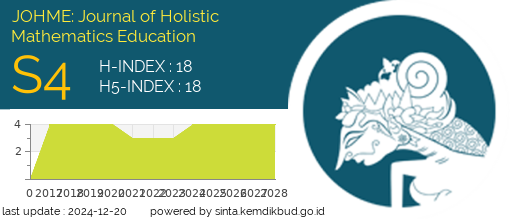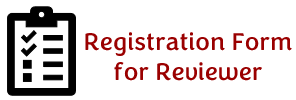LEARNING TRAJECTORY OF QUADRATIC INEQUALITY
DOI:
https://doi.org/10.19166/johme.v2i1.1202Keywords:
learning trajectory, quadratic inequality, didactical design research, learning obstacle, lintasan belajar, pertidaksamaan kuadrat, hambatan belajarAbstract
A learning trajectory offers a description of key aspects in planning mathematics learning. It also helps teachers follow and interpret students’ mathematical thinking, so that learning can be developed in accordance with the characteristics of students, and even become a tool for teachers to develop curriculum. There are three main components of learning trajectory: learning goals, learning activities, and hypothetical learning processes. In this article, we constructed a learning trajectory of the quadratic inequality. This qualitative study used didactical design research with 105 grade 10 students as the participants. In the prospective analysis step, didactic design, learning obstacle, and quadratic inequality system were analyzed. Based on the results of this analysis, we constructed hypothetical learning trajectories in the form of didactical design. Then, hyphothetical learning trajectories were implemented in the learning process. Student’s responses were analyzed qualitatively. Results of this analysis were used to revise the learning trajectory in order to obtain alternative trajectory learning outcomes of theoretical and empirical analysis. Finally, this article offers an alternative learning trajectory of quadratic inequalities that are different from the existing learning trajectories presented in the current textbook. The learning trajectory that is offered is the learning quadratic inequality which starts from the function approach.
BAHASA INDONESIA ABSTRACT: Learning trajectory (LT) menawarkan sebuah deskripsi akan aspek kunci dalam perencanaan pembelajaran matematika. LT juga membantu guru belajar dalam mengikuti dan menginterpretasi cara berpikir matematisnya siswa, sehingga pembelajaran dapat dikembangkan sesuai dengan karateristik siswa, bahkan menjadi alat bagi guru untuk mengembangkan kurikulum. Ada tiga komponen utama dari learning trajectory, yaitu: tujuan pembelajaran (learning goals), kegiatan pembelajaran (learning activities) dan hipotesis proses belajar siswa (hypothetical learning process). Dalam artikel ini akan dikonstruksi sebuah LT pertidaksamaan kuadrat. Penelitian ini menggunakan pendekatan kualitatif dengan didactical design research. Adapun partisipan sebanyak 105 siswa kelas X. Pada awal penelitian ini, dilakukan analisis propektif yaitu analisis atas materi pertidaksamaan kuadrat, hambatan belajar dan tingkat berpikir siswa. Kemudian dari hasil analisis ini disusunlah Hipotetical Learning Trajectories yang berupa desain didaktis. Desain didaktis berdasarkan Hypotetical Learning Trajectories ini diimplementasikan dalam pembelajaran. Respon siswa dianalisis secara kualitatif. Hasil analisis ini digunakan untuk merevisi Learning Trajectory, sehingga diperoleh Learning Trajectory alternatif hasil analisis teoritik dan empirik. Akhirnya, artikel ini menawarkan sebuah alternatif learning trajectory pertidaksamaan kuadrat yang berbeda dengan learning trajectories yang ada pada buku pelajaran sekarang. Learning trajectory yang ditawarkan adalah pembelajaran pertidaksamaan yang dimulai dengan pendekatan fungsi.
References
Bazzini, L., & Tsamir, P. (2001). Research based instruction: Widening students’ perspective when dealing with inequality. In K. Stacey, H. Chick, & M. Kendal (Eds.). Proceedings of the 12th ICMI Study The Future of Teaching and Learning of Algebra, volume 1 (pp. 61-68). Melbourne, Australia: Kluwer Academics Publisher. Retrieved from http://citeseerx.ist.psu.edu/viewdoc/download?doi=10.1.1.530.9955&rep=rep1&type=pdf
Bicer, A., Capraro, R. M., & Capraro, M. M. (2014). Pre-service teachers’ linear and quadratic inequality understanding. International Journal for Mathematics Teaching and Learning, 1(1), 1-10. Retrieved from http://www.cimt.org.uk/journal/bicer.pdf
Boero, P., & Bazzini, L. (2004). Inequalities in mathematics education: The need for complementary perspectives. In M. J. Hoines, & A. B. Fuglestad (Eds.). Proceedings of the 28th Conference of the International Group of Psychology of Mathematics Education, (pp. 139-143). Bergen, Norway: Bergen University College. Retrieved from https://www.emis.de/proceedings/PME28/
Clements, D. H., & Sarama, J. (2004). Learning trajectories in mathematics education. Mathematical Thinking and Learning, 6(2), 81-89. https://doi.org/10.1207/s15327833mtl0602_1
Kementrian Pendidikan dan Kebudayaan Republik Indonesia. (2013). Peraturan Menteri Pendidikan dan Kebudayaan Republik Indonesia nomor 81A tahun 2013 tentang implementasi kurikulum. Jakarta, Indonesia: Departemen Pendidikan Nasional.
Kieran, C. (2004). The equation/inequality connection in constructing meaning for inequality situations. In M. J. Hoines, B. Fuglestad, B., & Anne (Eds.), Proceedings of the 28th Conference of the International Group of Psychology of Mathematics Education (pp. 143-147). Bergen, Norway: University College. Retrieved from https://www.emis.de/proceedings/PME28/
Mullis, I. V. S., Martin, M. O., Foy, P., & Hooper, M. (2016). TIMSS 2015 international results in mathematics. Boston, MA: IEA. Retrieved from http://timss2015.org/download-center
Simon, M. (1995). Reconstructing mathematics pedagogy from a constructivist perspective. Journal for Research in Mathematics Education, 26(2), 114-145. https://doi.org/10.2307/749205
Simon, M. & Tzur, R. (2004). Explicating the role of tasks in conceptual learning: An elaboration of a hypothetical learning trajectory. Mathematical Thinking and Learning, 6(2), 91-104. https://doi.org/10.1207/s15327833mtl0602_2
Suryadi, D. (2013). Didactical design research (DDR) dalam pengembangan pembelajaran matematika. Proceeding seminar nasional matematika dan pendidikan matematika (pp. 3-12). Bandung, Indonesia: STKIP Siliwangi. Retrieved from http://repository.stkipgetsempena.ac.id/bitstream/383/1/SEMNAS-PMAT-2013.pdf#page=13
Tamba, K. P. (2015). The development of didactical design of quadratic inequality on senior high school students (Unpublished master’s thesis). Universitas Pendidikan Indonesia, Bandung, Indonesia.
Tsamir, P., & Almog, N. (2001). Student’s strategies and difficulties: The case of algebraic inequality. Mathematics Education Science Technology, 32(4), 513-524. https://doi.org/10.1080/00207390117469
Tsamir, P., & Bazzini, L. (2004). Consistencies and inconsistencies in student’s solution to algebraic ”˜singlevalue’ inequalities. Mathematics Education Science Technology, 35(6), 793-812. https://doi.org/10.1080/00207390412331271357
Tsamir, P., & Reshef, M. (2006). Students' preferences when solving quadratic inequality. Focus on Learning Problems in Mathematics, 28(1). Retrieved from https://www.questia.com/library/journal/1G1-151379487/students-preferences-when-solving-quadratic-inequalities
Van Brummelen, H. (2009). Walking with God in the classroom: Christian approaches to learning and teaching (3rd ed.). Colorado Springs, CO: Purposeful Design Publication.
Downloads
Published
How to Cite
Issue
Section
License
Authors who publish with this journal agree to the following terms:
1) Authors retain copyright and grant the journal right of first publication with the work simultaneously licensed under a Creative Commons Attribution License (CC-BY-SA 4.0) that allows others to share the work with an acknowledgement of the work's authorship and initial publication in this journal.
2) Authors are able to enter into separate, additional contractual arrangements for the non-exclusive distribution of the journal's published version of the work (e.g., post it to an institutional repository or publish it in a book), with an acknowledgement of its initial publication in this journal.
3) Authors are permitted and encouraged to post their work online (e.g., in institutional repositories or on their website). The final published PDF should be used and bibliographic details that credit the publication in this journal should be included.”










